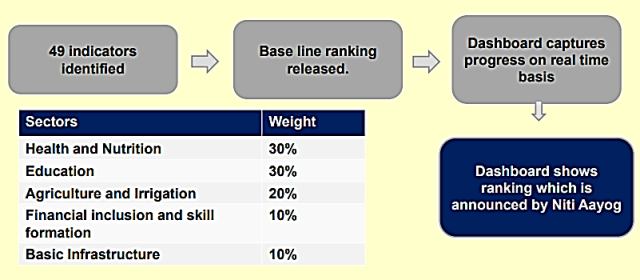Niti Aayog’s Aspirational Districts Programme
- 05 Nov 2019
- Despite on a high economic growth trajectory, India still lags behind in terms of Human Development Index as well as reduction in the significant inter-state and inter-district variations in development.
- To address both the issues, the Prime Minister launched the ‘Transformation of Aspirational Districts Programme (ADP) in January, 2018.
Aspirational Districts Programme (ADP)
- It aims to expeditiously improve the socio-economic status of 117 districts from across 28 states.
- Driven primarily by the States, this initiative focuses on the strengths of each district, and prioritizes the attainable outcomes for immediate improvement.
- NITI Aayog in partnership with the Government of Andhra Pradesh has created a dashboard - Champions of Change-Real-Time Monitoring Dashboard, for monitoring the real-time progress of the districts.
Objectives
- Mapping of skill profile of the district
- Appraisal of district skill ecosystem
- Identifying district specific challenges and potential areas of support required in the district
- Development of District Skill Development Plan through consultation process
- Implementation support for the work plan to the districts
Core Principles
- The three core principles of the programme are –
- Convergence (of Central & State Schemes)
- Collaboration (among citizens and functionaries of Central & State Governments including district teams)
- Competition among districts
Focus Areas
- The ADP focuses mainly on following themes- Health & Nutrition, Education, Agriculture & Water Resources, Financial Inclusion, Skill Development and Basic Infrastructure.
- 49 key performance indicators (KPIs) with 81 data points have been chosen to measure progress of the districts.
| Focus Areas | Weight | Data-Points | No. of Indicators |
| Health & Nutrition | 30% | 31 | 13 |
| Education | 30% | 14 | 08 |
| Agriculture & Water Resources | 20% | 12 | 10 |
| Financial Inclusion | 5% | 06 | 11 |
| Skill Development | 5% | 10 | |
| Basic Infrastructure | 10% | 08 | 07 |
Source: NITI Aayog
- Health & Nutrition: Main focus on antenatal care, postnatal care, gender parity, health of new-born, growth of children, contagious diseases, and health infrastructure.
- Education: Focus on learning outcomes (transition rate from primary to upper primary, and subsequently to secondary schooling, average scores in mathematics and languages etc.), as well as infrastructural (toilet access for girls, drinking water, electricity supply) and institutional indicators (Right to Education, mandated pupil-teacher ratio)
- Agriculture & Water Resources: Focus on outputs (yield, price realisation etc.), inputs (quality seed distribution, soil health cards), and institutional support (crop insurance, electronic markets, artificial insemination, animal vaccination).
- Financial Inclusion:Focus on schemes such as Atal Pension Yojana, Pradhan Mantri Jeevan Jyoti Bima Yojana etc.), reach of institutional banking (number of accounts opened under Jan DhanYojana), and ease of institutional financing for small businesses (disbursement of Mudra loans).
- Skill Development: Focus on skilling of youth, employment, and the skilling of vulnerable/marginalized youth under Pradhan Mantri Kaushal Vikas Yojana (PMKVY).
- Basic Infrastructure: Focus on housing for all with drinking water, electricity, road connectivity, internet connected Gram Panchayats, and panchayats with Common Service Centres.
Analysis
The ADP brings together all levels of government, from central and state officers driving operations, to the district collectors implementing innovative measures on the ground. It also tracks progress through real-time data collection.
A critical aspect of the programme’s approach is its focus on district-specific strengths and the identification of low-hanging fruit. In addition to tailoring interventions to districts, the programme is novel in four important ways:
- The programme shifts the focus away from inputs and draws attention to socio-economic outcomes, such as learning and malnutrition, at the highest echelons of the government.
- Through its large-scale efforts to collect, distill and disseminate data, the programme is grounded thoroughly in evidence. The NITI Aayog has created a dashboard to monitor real-time progress in the districts. The availability of the latest district-level statistics in the public domain is not only enhancing transparency and accountability, but it is also ensuring that policy actions are backed by evidence.
- The ADP amplifies the government’s belief that states and districts should have a greater voice in their development. It truly embodies India’s shift toward cooperative federalism. The local, state and central governments work together to design, implement and monitor measures to drive development in the districts.
- The programme is a collaborative effort between government, various foundations and civil society. Through partnerships with several voluntary organisations, the programme benefits from different perspectives, technical skills and on-the-ground experience. For example, NITI Aayog is working with Piramal Foundation to strengthen public systems particularly in health and education. Similarly, Tata Trusts, IDinsight, L&T, ITC and the Bill and Melinda Gates Foundation are also playing key roles in the programme. These public-private partnerships will help boost implementation of the programme.
Way Forward
- In a diverse country like India, balanced growth is a prerequisite for overall development. ADP is a radical departure from the country’s previous development strategies in its scale, scope and ownership. Implicit in the design of the programme is the fact that India’s economy cannot sustain growth without improving human development for all its citizens.
- ADP is a laboratory of various cutting-edge governance reforms which aims to address governance issues by using a combination of approaches: lifting levels of aspirations through a vision and district plan,adequate institutional arrangements and convergence in all stakeholders’ efforts and above all, ranking based public competition among the districts by setting up a real-time monitoring mechanism.
- The Government is committed to raising the living standards of its citizens and ensuring inclusive growth for all – “Sabka Saath Sabka Vikas”. To enable optimum utilization of their potential, ADP focuses closely on improving people’s ability to participate fully in the vibrant economy.





